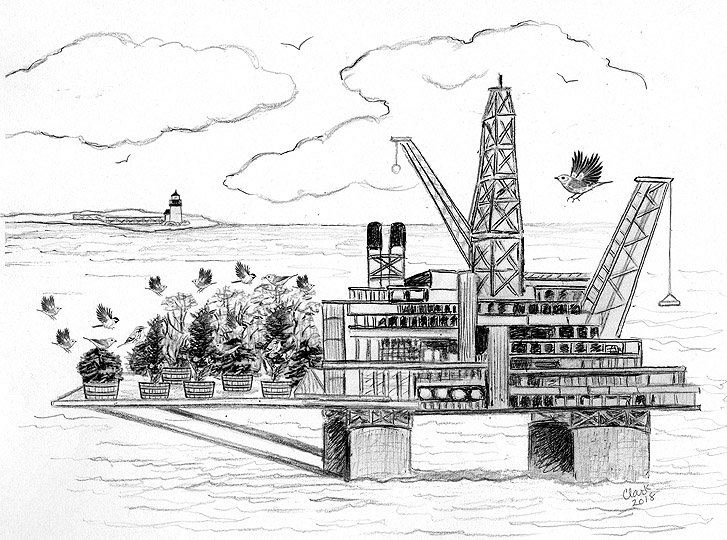
Dear Bird Folks,
I recently saw a poster advertising a brand new ferry service. The ferry will transport birders to new offshore birding sites. It didn’t explain the location of these sites, only that they would be “available soon.” It sounds kind of exciting, but I’d like to know more about it. Have you heard of this?
– Glenn, Centerville, MA
Yes, I have, Glenn,
I’ve heard of these new birding sites and you probably have too, you just don’t know it. Let me explain. Anyone who has been out at sea, whether it be on a fishing boat, a pleasure craft or even a cruise ship, has likely seen songbirds land on the boat. Tired migrating birds often alight on boats to rest and seek food. Sometimes these birds recover and continue on their way, but often they simply succumb to exhaustion. An estimated two million birds perish each spring because they simply don’t have the strength to go on. Can anything be done to help them? For years wildlife officials have discussed setting up a series of small artificial islands, which would be equipped with natural cover, food and fresh water. This was basically a pipedream since such a project would likely be cost-prohibitive. Well, there’s good news on the horizon, literally. These floating oases have become a reality and they are on the way here…but some people aren’t happy about it.
First, let’s discuss the good news. After ten years of research, Micro-Plot LoL, a nonprofit company just outside of Grand Bay National Estuarine Reserve in Mississippi, has developed a compact, self-sustaining ecosystem. Micro-Plot builds small (50’X50’) mini-habitats. Each plot contains salt-resistant plants, water desalination pumps and the eggs of sham beetles, which are tiny insects that thrive in a marine habitat. In 2007, twenty of these ecosystems were constructed on the helipads of defunct oil platforms in the Gulf of Mexico. At first only lost and tired birds were seen drinking and eating on the platforms. But as the years passed, migrating warblers, swallows, thrushes and even hummingbirds routinely used these artificial rest stops as they crossed the Gulf. An estimated 1,100 songbirds now use one of these platforms on any given day. These plots have been so successful that more are being installed. So, where’s the bad news? Oh, it’s coming.
There was scant protest on Dec. 17, 2017 when the Department of the Interior announced they had rescinded the ban on oil drilling along the Eastern seaboard. This was news no one wanted to hear, but we all thought any such drilling would be decades down the road. Certainly the oil barons would be met with an avalanche of red tape, regulatory hurdles and legal setbacks. Not anymore. Back in August a string of executive orders rescinded most of the regulations dealing with oil exploration. With the stroke of a pen, our once protective environmental laws evaporated. More importantly, the states and local communities affected by such drilling are now powerless to do anything about it. (So much for states’ rights.)
Ironically, the folks who fought so hard to keep wind turbines from being built off of our shores have inadvertently opened the door for oil rigs. Unlike the turbines, which are still heavily regulated and need to be constructed onsite, these oil rigs are already built, have been preapproved and are on the way as we speak.
Like prefab houses, today’s’ oil platforms are assembled in shipyards and towed into place by tugboats. Once a platform reaches its destination, the anchors and stabilizing legs are dropped and it soon becomes operational. And in another strange twist, these new oil platforms are powered by – solar panels. That last fact even made me laugh…and shake my head.
It’s no secret that the oil executives are bullies, but they can also be shrewd when they need to be. In order to quell widespread protests from environmental groups, the oil people have outfitted each one of these coming platforms with the aforementioned bird-friendly microhabitats. This puts birders in a tough spot. Should we complain about the ugly and potentially disastrous oil rigs, or do we accept the inevitable and appreciate the new birding habitat? I mean, what birder doesn’t want to see 1,100 songbirds without having to deal with mosquitoes, ticks and poison ivy? Also, Cape Codders, who for years have had to pay exorbitant gasoline and heating oil prices, now stand to have some of the cheapest fuel in the country. Lots of folks are going to like that…I guess.
Where will these rigs be located? Good question. As of now that information has been kept under wraps. However, the advertisement you mentioned does offer some clues. The company, “Rigged Tours of Cape Cod,” has an office located on Ocean Street, near Hyannis Harbor. Thus, it’s pretty obvious that Rigged Tours wants to have access to Nantucket Sound. In addition, the birding tours are only two hours long, which tells me the platforms will most certainly be close by and visible from shore. Yikes!
It’s been a tough year for Cape Codders, Glenn. First, we lost Liam’s at Nauset Beach and now this. Hopefully, we will at least get a chance to see some cool birds, but I’m not thrilled about the rest of it. According to the Interior Department’s website, they plan to have thirty-six platforms up and running by the end of the year, with the first of them arriving just off our shores by this Sunday, April 1st.